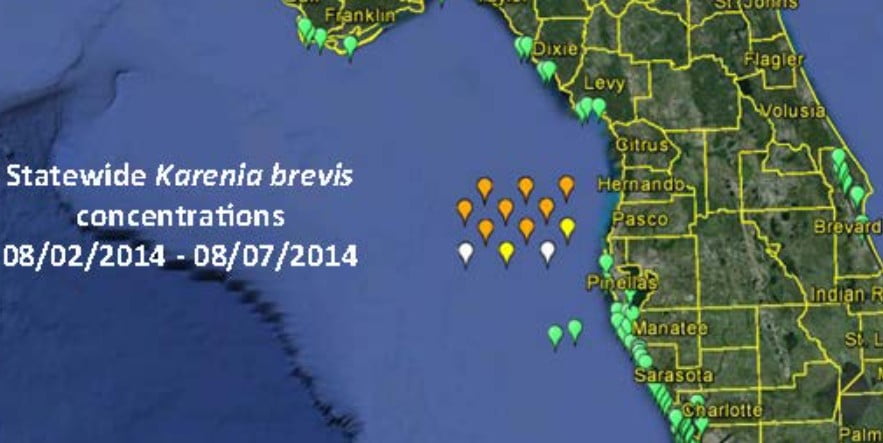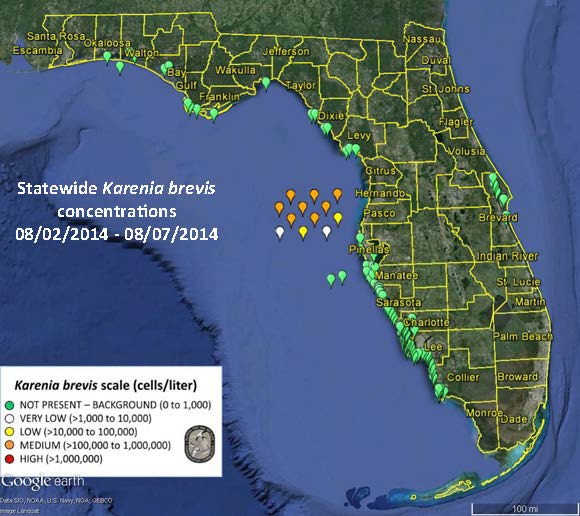Red tide kills thousands of fish in Gulf of Mexico, poses a greater health threat

The largest red tide bloom seen near Florida since 2005 has already killed thousands of fish and may pose a greater health threat if it washes ashore as expected. The bloom is located about 20 miles (32 km) off the coast of Florida and is about 60 miles (96 km) wide and 90 miles (144 km) long.
The water in the deep regions of the bloom is headed southeast, but the part on the surface is expected to move south and reach southwestern coast of Florida by the end of August.
According to August 8th summary report of current red tide conditions around Florida by Florida Fish and Wildlife Conservation Commission (FWC), Karenia brevis, the Florida red tide organism, was detected in low to medium concentrations in several water samples from offshore of Hernando, Pasco, and Pinellas counties.
“Satellite images from the Optical Oceanography Laboratory at the University of South Florida show a patchy bloom up to 60 miles (96 km) wide and 90 miles (144 km) long, at least 20 miles (32 km) offshore between Dixie and northern Pinellas counties in northwest and southwest Florida. This bloom has caused an ongoing fish kill.
FWC’s Fish Kill Hotline has received reports of thousands of dead and moribund benthic reef fish including various snapper and grouper species, hogfish, grunts, crabs, flounder, bull sharks, lionfish, baitfish, eel, sea snakes, tomtates, lizardfish, filefish, octopus, and triggerfish.
Water discoloration and respiratory irritation have been reported offshore in the bloom patch.
Forecasts by the Collaboration for Prediction of Red Tides show little movement of the surface bloom and slow east/southeast movement of bottom waters, which should keep the bloom offshore within the next few days.”

“It could have large impacts if it were to move inshore,” said Brandon Basino, a spokesman for the FWC. “It has been killing a lot of marine species, especially fish, as it waits offshore.”
Last week, state wildlife officials organized a three-day boating expedition to map the bloom and predict its movement. They have found evidence of red tide at the bottom of the ocean, where it is expected to be swept by currents and carried to land, potentially affecting beaches north and south of Tampa.

While many people call these blooms ‘red tides,’ the bloom can be green, brown, red, or colorless. Therefore, scientists changed the name to Harmful Algal Blooms (HABs). HABs occur when colonies of algae – simple plants that live in the sea and freshwater – grow out of control while producing toxic or harmful effects on people, fish, shellfish, marine mammals, and birds. The human illnesses caused by HABs, though rare, can be debilitating or even fatal.
Since scientists started to observe HABs, they appear to be occurring more often, according to NOAA. The increased frequency of HABs is a major concern; these events can make people sick when contaminated shellfish are eaten or when people breathe toxic air sprayed from a beach with a harmful algal bloom.
HAB events can result in the closure of beaches and shellfish beds, massive fish kills, death of marine mammals and seabirds, and alteration of marine habitats. This hurts commercial and recreational fishing, tourism, and valued habitats, which are important local economies and the livelihood of coastal residents. (NOAA)
Featured image: TW

Here's a good video on this. https://www.youtube.com/watch?v=BR1sMP9H5e4